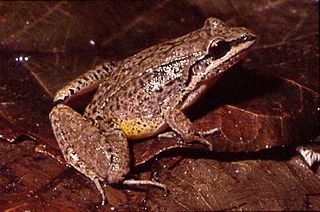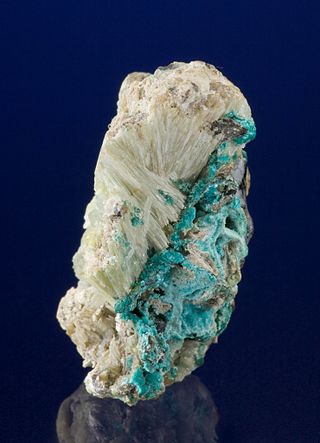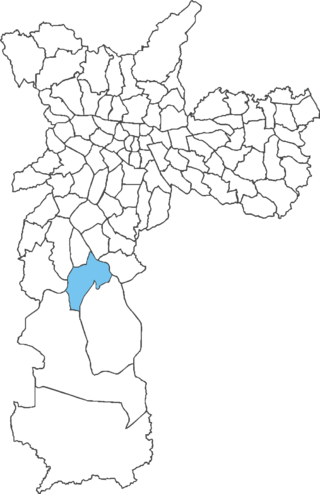
Iporanga is a municipality in the state of São Paulo in Brazil. The population is 4,199 in an area of 1152 km2. The elevation is 81 m.

Leptodactylus notoaktites is a species of frog in the family Leptodactylidae. It is endemic to southeastern Brazil and is known from the states of Santa Catarina, Paraná, and São Paulo state. Common name Iporanga white-lipped frog has been coined for it.

Pimelodella kronei is a species of three-barbeled catfish endemic to Brazil. Discovered by the German naturalist Sigismund Ernst Richard Krone, it was the first troglobitic fish described in Brazil, but several others have been described later.

Bertolonia is a genus consisting of 14 species of pretty, dwarf, creeping, tender perennials, native to tropical South America. These herbaceous plants are grown for their colorful, velvety, ornamental foliages, vary from shimmery white with purple, pink with purple, or bronze-green with carmine and lighter midribs, purple beneath. Leaves are coarsely hairy, oval 7 cm (3 in) long on short stalks. The plants bear clusters of small, bell-shaped flowers repeatedly, just above the leaves, color ranges from pink, red, yellow to purple.

Passiflora loefgrenii, the garlic passion fruit, is a passion flower first formally described in 1997 by Fabio Augusto Vitta. The plant is named after Albert Löfgren, the first known collector.

Sigismund Ernst Richard Krone was a German naturalist, zoologist, spelunker, archaeologist and researcher born on 18 June 1861 in Dresden, Kingdom of Saxony. Having been the discoverer of the Devil's Cave in 1891, he explored and studied the endokarst region of southeast Brazil,. He was influenced by the contributions of the Danish naturalist Peter Lund (1801–1880), leading to the realization of several paleontological and archaeological discoveries in 41 of Iporanga's caves, which he examined between 1895 and 1906.
Gruta das Areias is a complex of caverns located in the region of Lajeado, in the municipality of Iporanga, São Paulo, Brazil. It is therefore part of the Areias System, located in the southwestern part of the carbonatic area Lajeado-Bombas, on the right bank of the Betari river, in the municipality of Iporanga, southeast of the state. It comprises the caves Ressurgência das Areias (SP-016), the 5.565 meter-long cave Areias de Cima (SP-018) and the Areias de Baixo (SP-019) cave, also popularly called Areias I and II. It is also part of the so-called Açungui group of caverns formed between the Mesoproterozoic and Neoproterozoic, between 1.6 billion and 539 million years ago.

Susannite is a lead sulfate carbonate hydroxide mineral. It has the formula Pb4SO4(CO3)2(OH)2. Susannite is the higher temperature phase of the two and forms above 80 °C when fluids oxidize the lead ore deposits. It is trimorphous with leadhillite and macphersonite.

Cnesterodon is a genus of poeciliids native to South America.

Cidade Dutra is one of 96 districts in the city of São Paulo, Brazil.

Vale do Ribeira is a region in the south of the state of São Paulo and the northeast of the state of Paraná, Brazil. It contains a large part of the Ribeira de Iguape River valley, from which it takes its name, as well as the coastal Iguape-Cananéia-Paranaguá estuary lagoon complex. The region is environmentally rich, with large areas of well-preserved Atlantic Forest, but economically poor.
Geoplana iporanga is a species of land planarian belonging to the subfamily Geoplaninae. It is found in areas of the Atlantic Forest within Intervales State Park in Brazil.
Cnesterodon carnegiei, commonly known as Carnegie's toothcarp, is a species of poeciliid native to southeastern Brazil and Uruguay.
Cnesterodon raddai, the Resistencia toothcarp, is a species of poeciliid native to the Paraguay and lower Paraná River basins.
Cnesterodon omorgmatos, the Cilida toothcarp, is a species of poeciliid native to the Paranapanema River basin in Brazil.
Cnesterodon holopteros, the whole fin toothcarp, is a species of poeciliid native to the Río Uruguai drainage.
Cnesterodon brevirostratus, is a species of poeciliid found in Brazil.
Cnesterodon septentrionalis, is a species of poeciliid found in Brazil.

Cnesterodon decemmaculatus, the ten spotted live-bearer, is a species of poeciliid native to Argentina and Uruguay.
Cnesterodon pirai, the Almeida toothcarp, is a species of poeciliid that is only know from its type locality, the arroyo Almeida, an affluent of the arroyo Cuñá-Pirú, in the Río Paraná basin, Aristóbulo del Valle, Misiones in Argentina.









